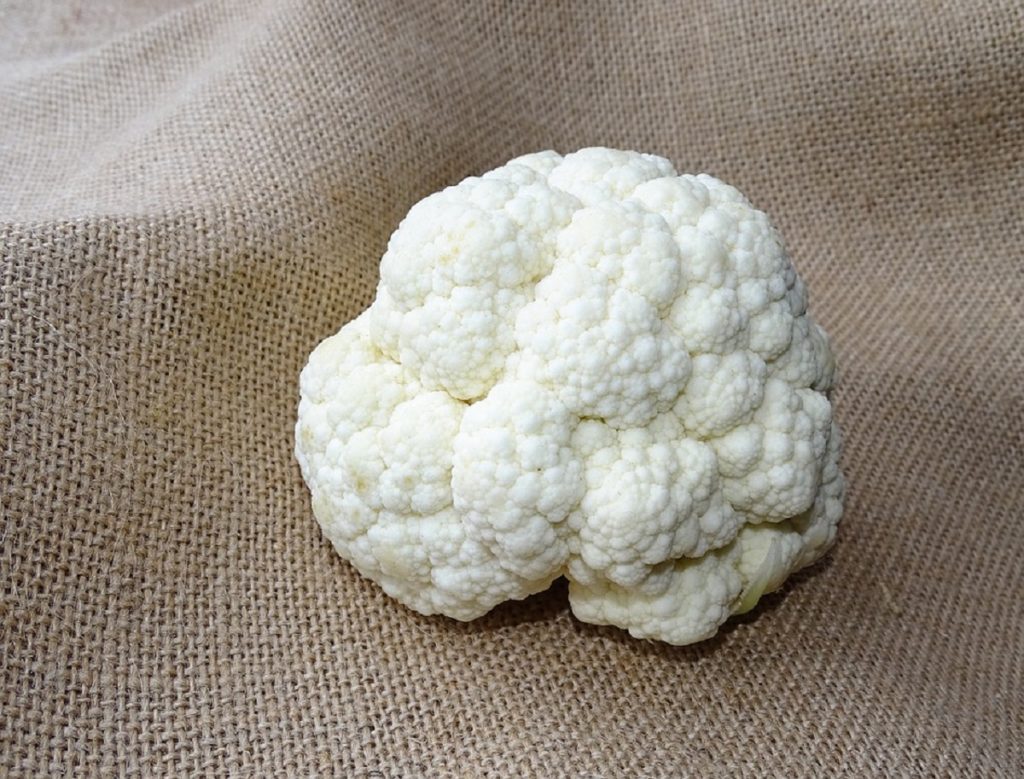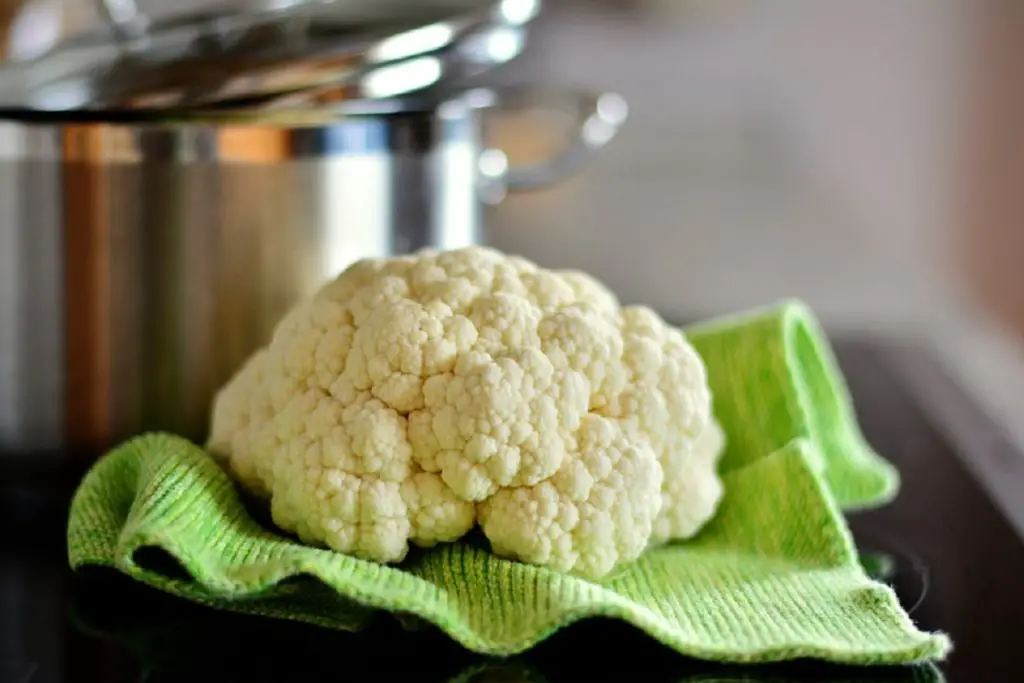Most vegetables have a short shelf life, even if kept in the fridge. So what is the answer? That’s simple. All you have to do is freeze them. Of course, it varies as to what vegetable it is, and not all vegetables freeze as well as others.
However, in this article, we will take a look at how you can freeze cauliflower so that it tastes as it did when it was fresh. It isn’t difficult to either freeze cauliflower (see also Can You Freeze Cauliflower Cheese?) or defrost it so if you find that there is a sale on cauliflower, it’s worth investing in some.

You might be a single person who can’t use a whole cauliflower in one go, and if so, this article is for you.
Picking Your Cauliflower and Preparing it
To get excellent results when freezing your cauliflower, try and find the best cauliflower in the store. The florets should be firm and there shouldn’t be any dark blemishes on them.
Having purchased the cauliflower, it is time to prep it ready for freezing. Remove the leaves and then wash the cauliflower thoroughly. It is a good idea to cut it into florets before you wash it. It is easier to get to the dirt this way.
In addition, you may be concerned about bugs. If so, put the cauliflower in cold salty water for about half an hour. This should get rid of the bugs. They’ll probably end up at the bottom of the bowl anyway.
If you haven’t already done so, cut the cauliflower into florets. It can be difficult to decide how big or small to make them. You might want to use the florets in a soup. Then it is more sensible to cut them into smaller florets as they will be mashed up.
If you are making roast cauliflower, it could be a good idea to cut the florets a little larger. In addition, the smaller the florets are, the more versatile they will be. They will also defrost more quickly than large florets.
Freezing Cauliflower
There are two ways that we recommend freezing cauliflower (see also How To Freeze Broccoli). The first is blanching, which is used for many vegetables, for example, broccoli, parsnips, and turnips (see also Can You Freeze Jicama?). The second option is to freeze roasted cauliflower (see also How To Freeze Roasted Vegetables).
The Methods for Freezing Cauliflower
1. Blanching
- Fill a large pot with enough water to cover the florets completely. This ensures that they cook evenly. Bring the water to boil and cook the cauliflower for around two and a half minutes. The time does, of course, depend on the size of the florets. If they are large, you may have to cook them for longer. Additionally, if you have a lot of cauliflower, you may have to blanch it in batches.
The next step is to get rid of the boiling water and put the florets in a bath of cold
Water and leave for three minutes. Then pour away the water
- Before you put the cauliflower florets in the freezer, drain them in a colander and then pat them dry with paper towels or a dishtowel. Then leave them to dry on a dishcloth for half an hour. If you leave too much water on the cauliflower, it will form ice and when it defrosts, there will be water which will make the cauliflower mushy.
- You then have to decide how much cauliflower you will need for a meal and divide the florets into portions. If you’re not sure, freeze them in smaller portions. In that way, you can defrost as much as you need. If the portion is too large, you may be left with too much cauliflower.
- Put the cauliflower florets into either airtight containers or freezer bags. If you are using freezer bags, make sure that you get all of the air out of them otherwise the cauliflower may get freezer burn which can make it inedible.
- It’s a good idea to put the date on which you froze the cauliflower on the bags or containers. If you freeze a lot of products, it is hard to remember when you froze different items.
- Put the bags or containers in the freezer.
Remember that it takes less time to reheat blanched cauliflower than it does fresh.
Freezing Roasted Cauliflower

Roasted cauliflower is delicious. You can make it with all sorts of spices to suit your taste. It is easy to prepare for freezing, probably easier than freezing blanched cauliflower. You don’t have to go through the whole procedure of blanching and patting dry the florets which can be time-consuming. Here is what you have to do.
- Cut the cauliflower into florets to your preferred size.
- Preheat the oven to 430 degrees Fahrenheit.
- Shake off any water on the florets. You don’t need to pat them dry as any excess water will evaporate in the oven.
- Mix together a tablespoon of olive oil and a tablespoon of balsamic vinegar. To this add salt and pepper and any spices you like. Chili is a good choice if you like spice and you could add some cumin to this. If you want something a little milder go for sweet paprika. If you like herbs, try out rosemary and thyme. They are a great match. Then coat each cauliflower floret with the mixture. Make sure that each floret has the same amount of mixture on it as you want them to all taste the same. The best way to do this is to put the mixture in a bowl and stir in the florets. You may need more of the mixture if you have a lot of cauliflower.
- Get a baking sheet and line it with aluminum foil. Put the florets on this in a single layer with space in between them. You don’t want them to stick together as that may lead to uneven reheating time.
- The next step is to put the baking sheet in the oven for 25 minutes. Before you take the florets out of the oven, check that they are done with a fork. You can always leave them in the oven for a little longer if they’re not done. However, you don’t want them to be overcooked as that can mean that the cauliflower will go mushy when defrosted.
- Take the baking sheet out of the oven when the cauliflower is ready and leave it to cool down at room temperature.
- Once cool, put the cauliflower florets in a freezer bag or an airtight container. Once again, make sure that you squeeze out all the air from the freezer bags if you are using them.
- Write the date on a label and stick it on the container or bag so you don’t forget the freezing date.
- Put the bags or containers in the freezer.
Defrosting Frozen Cauliflower
There are a few different ways to defrost frozen cauliflower and it’s really just up to personal preference and when you want to use it.
- Put it straight into what you are cooking without defrosting. This works well if you are making a cauliflower soup. The florets won’t take long to defrost in a hot soup and the same goes for a stew or curry. Just add a few minutes of cooking time to ensure that the florets have defrosted and heated up enough. This is by far the easiest way to defrost cauliflower florets as it takes such a short amount of time.
- Defrost the cauliflower florets in the fridge. You can do this overnight or you can just take them out of the freezer in the morning for use in the evening. This doesn’t take much effort, but you have to remember to take the cauliflower out of the freezer. That may sound simple, but if you’ve had a hard day, it is easy to forget.
- Use a frying pan to defrost the cauliflower florets. All you have to do is heat up the cauliflower in the pan on a very low heat so that the heat has a chance to permeate the florets and you don’t get a burnt outside and a cold inside. Once the cauliflower has thawed out, there will be some water in the pan. You can then reheat it for a few minutes. This works well with cauliflower that has been roasted, but if you blanched the florets, they will need more water and cooking time. You can cook them in olive oil for a minute or so after the water has evaporated.
